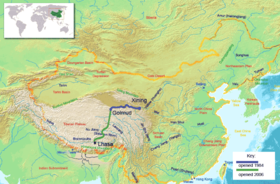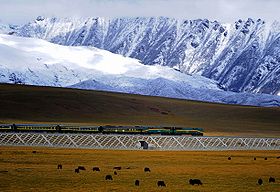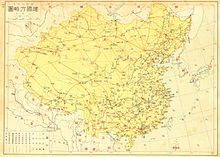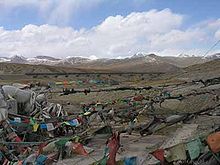- Qinghai–Tibet Railway
-
The Qinghai–Xizang railway, Qingzang railway, or Qinghai–Tibet railway (simplified Chinese: 青藏铁路; traditional Chinese: 青藏鐵路; pinyin: Qīngzàng Tiělù; Tibetan: mtsho bod lcags lam མཚོ་བོད་ལྕགས་ལམ།), is a high-elevation railway that connects Xining, Qinghai Province, to Lhasa, Tibet Autonomous Region, in People's Republic of China.
The total length of Qingzang railway is 1956 km (1215 mi). Construction of the 815 km (506 mi) section between Xining and Golmud was completed by 1984. The 1142 km (709 mi) section between Golmud and Lhasa was inaugurated on 1 July 2006 by president Hu Jintao: the first two passenger trains were "Qing 1" (Q1) from Golmud to Lhasa, and "Zang 2" (J2) from Lhasa.[1] This railway is the first to connect the Tibet Autonomous Region to any other province, which, due to its elevation and terrain, is the last province-level entity in mainland China to have a conventional railway. Testing of the line and equipment started on 1 May 2006.[2] Passenger trains run from Beijing, Chengdu, Chongqing, Guangzhou, Shanghai, Xining and Lanzhou.[3]
The line includes the Tanggula Pass, which, at 5,072 m (16,640 feet) above sea level, is the world's highest rail track. The 1,338 m Fenghuoshan tunnel is the highest rail tunnel in the world at 4,905 m above sea level. The 4,010-m Guanjiao tunnel is the longest tunnel from Xining to Golmod and the 3,345-m Yangbajing tunnel is the longest tunnel from Golmod to Lhasa. More than 960 km, or over 80% of the Golmud-Lhasa section, is at an elevation of more than 4,000 m. There are 675 bridges, totalling 159.88 km, and about 550 km of the railway is laid on permafrost.
Contents
Stations
Main article: List of stations on Qingzang railwayNanshankouGanlongNachitaiXiaonanchuanYuzhufengWangkunBudongquanChumaerheWudaoliangXiushuiheJiangkedongRiaquchiTuotuoheTongtianheYanshipingBuqianggeZhajiazangbuTuojuAmdoCuonahuDiwumaGangxiuTuoruGuluWumatangDaqiongguoYangbajingMaxiang● Ordinary station
● Station with vista point
Note: stations in gray are unstaffed
Note: this image is not to scaleIn the Golmud to Lhasa part of the line, 45 stations are open, 38 of which are unstaffed, monitored by the control center in Xining. Thirteen more stations are planned.[4]
Trains and tickets
The trains are specially built for high elevation environment. The diesel locomotives used on Golmud-Lhasa section were made by GE in Pennsylvania, and the passenger carriages are Chinese-made 25T carriages: on train T27/T28, between Beijing West and Lhasa, Bombardier Sifang Transportation (BSP) made carriages on the Golmud-Lhasa section in deep green/yellow or deep red/yellow. Signs in the carriages are in Tibetan, Simplified Chinese and English. The operational speed is 120 km/h, 100 km/h over sections laid on permafrost.
The 1,142-km Qinghai–Tibet railway from Golmud to Lhasa was completed on 12 October 2005. It opened to regular trial service on 1 July 2006.[5]
A Passenger Health Registration Card is required to take the train between Golmud and Lhasa. The card can be obtained when purchasing the ticket. Passengers must read the health notice for high-elevation travel and sign the agreement on the card to take the train. On 28 August 2006 a 75-year-old Hong Kong man was reported to be the first passenger to die on the train, after he had suffered heart problems in Lhasa but insisted on travelling to Xining. [6]
At the beginning, only three daily trains were available: Beijing–Lhasa (every day), Chengdu/Chongqing–Lhasa (each every other day), Lanzhou/Xining–Lhasa. Shanghai/Guangzhou–Lhasa service were added in October 2006. In July 2010, Shanghai–Lhasa service became daily, and one more daily service between Xining and Lhasa were added, but the service then suspended as winter low season came.
Oxygen and medical supply
From October 2006 five pairs of passenger trains run between Golmud and Lhasa, and one more pair between Xining and Golmud. The line has a capacity of eight pairs of passenger trains, and the carriages are specially built and have an oxygen supply for each passenger. Every passenger train has a doctor.
Construction
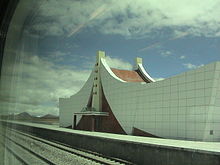 Tanggula railway station, located at 5,068 m, is the highest station in the world
Tanggula railway station, located at 5,068 m, is the highest station in the world
A projected railway to Tibet was included in Dr. Sun Yat-sen's proposal in 1917–1920 to build 100,000 km. of track across the entire country.[7]
Since the formation of the Tibetan Autonomous Region in early 1950s, the Chinese government pursued Dr. Sun's aim of a railway to Tibet. Engineers were sent to investigate the possibility, but a shortage of technology and money prevented the project from starting.
The capital of the Qinghai Province, Xining, became connected with the rest of the country by rail in 1959, when the Lanqing Railway from Lanzhou was completed.
The 815 km section of the future Qinzang Railway from Xining to Golmud, Qinghai opened to traffic in 1984. But the remaining 1,142 km section from Golmud to Lhasa could not be constructed until technical difficulties of building railroad tracks on permafrost were solved. This section was formally started on 29 June 2001, finished on 12 October 2005, and signalling work and track testing took another eight months. It was completed in five years at a cost of $3.68 billion.
Track-laying in Tibet was launched from both directions, towards Tanggula Mountain and Lhasa, from Amdo Railway Station on 22 June 2004. On 24 August 2005, track was laid at the railway's highest point, the Tanggula Pass, 5,072 m (16,640 feet) above sea level.[8]
There are forty-four railway stations, among them Tanggula Mountain railway station, at 5,068 m the world's highest (Cóndor station, at 4,786 m, on the Rio Mulatos-Potosí line, Bolivia, and La Galera station at 4,777 m, in Peru, being the next highest). The Qingzang Railway project involved more than 20,000 workers and over 6,000 pieces of industrial equipment, and is considered one of China's major accomplishments of the 21st century.
Bombardier Transportation provided 361 high-altitude passenger carriages with special enriched-oxygen and UV-protection systems, delivered between December 2005 and May 2006. Fifty-three are luxury sleeper carriages for tourist services.[9]
The construction of the railway was part of the China Western Development strategy, an attempt to develop the western provinces of China, which are much less developed than eastern China. The railway will be extended to Zhangmu via Shigatse (日喀则) to the west, and Dali via Nyingchi (林芝) to the east. A further extension is planned to link Shigatse with Yadong near the China-India border [10] (Map [11]). The railway is considered one of the greatest feats in modern Chinese history by the government, and as a result is often mentioned on regular TV programs. Chinese-Tibetan folk singer Han Hong has a song called Tianlu (Road to Heaven; 天路) praising the Qingzang Railway.
Future extensions
In a meeting between Chinese and Nepalese officials on 25 April 2008, the Chinese delegation announced that country's intention to extend the Qingzang railway from Lhasa to Zhangmu (Nepali: Khasa) on the Nepalese border. Nepal had requested that the railway be extended to enable trade and tourism between the two nations. Construction of the extension is planned to be completed by 2013.[12] On 17 August 2008, a railway spokesman confirmed plans to add six more rail lines to the Qinghai-Tibet railway. The six new tracks include one from Lhasa to Nyingchi and one from Lhasa to Xigaze, both in the Tibet Autonomous Region. Three tracks will originate from Golmud in Qinghai province and run to Chengdu in Sichuan province, Dunhuang in Gansu province, and Korla of the Xinjiang Uygur Autonomous Region. The sixth will link Xining, capital of Qinghai, with Zhangye in Gansu. The six lines are expected to be completed and put into operation before 2020.[13] Construction work of the Lhasa–Shigatse extension has been started on September 26, 2010.[14]
Potential link to India
Although the Chinese Ministry of Railways spokesman of the Qinghai–Tibet Railway has announced extending the railway southward to Shigatse,[15] it has not confirmed a further extension eventually with India, Bangladesh and other railway networks, however the land bridge concept from time to time rumors in various newspapers.
The Qinghai–Tibet Railway once opened to traffic was not only a change in Tibet's history without railway, but also will change China and India, two Asian powers who do not have a railway on the border. In the original construction of the Qinghai–Tibet Railway, some had forecast that China will add an overseas extension of the Qinghai-Tibet railway to the border towns of East Asia, South Asia through this route.
The extension to the Shigatse region and Nyingchi has been confirmed by the relevant government departments in Tibet. In fact, the Qinghai–Tibet Railway will be connecting close to India. An official in charge of the Tibet Autonomous Region Development and Reform Commission had pointed out: "Tibet Railway is completed, with Lhasa as the basis, will be built east of Lhasa to Nyingchi line from Lhasa to Shigatse west building line of the south building of the Qinghai-Tibet Shigatse to East Asia and other three Railway Line. These extensions will be opened to traffic within a decade. then, the three railway extension will form a large Y-shape, the length will be over two thousand kilometers. "
Although the Chinese government has never planned an extension to India's railway, many people have embarked on the possibility of this. Qinghai People's Congress, Vice Secretary General Liu Palit is one of them. In an interview, "21st Century Business Herald" interview, he supported a motion to establish a connection between the Pacific and Indian railway bridge on land, possibly linking the east coast port city of Lianyungang, eastern China, Xi'an, Lanzhou, Xining, Lhasa, Shigatse, through Nepal, and finally arriving in Patna, India, New Delhi, Mumbai and Karachi (Pakistan), China and India and Pakistan to achieve rail transport.
Liu Palit thinks has stated regarding the Qinghai-Tibet Plateau in South Asia continental bridge, "The past is not the Qinghai-Tibet Railway, which route is the only choice, now, starting from Tibet, a land bridge political more meaningful. " If the idea of the railway arrived in Nepal's plains region of Nepal, it is very easily connected with the Indian railway network. Experts said that "if the railway opened in Nepal, but also enable the railway system in India and Bangladesh, Nepal and China through connectivity, all countries will benefit."[16]
As India has been extending its railway near the Nathu La pass with China, and China has plans to extend the Qinghai-Tibet railway to near its border with Nathu La, a petition was set up to promote the idea that both countries could link up their respective proportions for train services between the two countries. As of 26 Aug 2011, the petition had 77 members.[17]
Engineering challenges
There are many technical difficulties for such a railway. About half of the second section was built on barely permanent permafrost. In the summer, the uppermost layer thaws, and the ground becomes muddy. Chinese engineers dealt with this problem by building elevated tracks with foundations sunk deep into the ground, building hollow concrete pipes beneath the tracks to keep the rail bed frozen, and using metal sun shades.[18] Similar to the Trans-Alaska Pipeline System portions of the track are also passively cooled with ammonia based heat exchangers.
The air in Tibet is much thinner, with a oxygen partial pressure being 35% to 40% below the partial pressure at sea level. Special passenger carriages are used, and several oxygen factories were built along the railway. At this elevation in these latitudes, water in toilets must be heated to prevent freezing. The Chinese government claimed that no construction workers died during the construction due to altitude sickness related diseases.[19] The railway passes the Kunlun Mountains, an earthquake zone. A magnitude 8.1 earthquake struck in 2001. Dozens of earthquake monitors have been installed along the railway.
Economic and environmental impact
With limited industrial capacity in Tibet, the Tibetan economy heavily relies on industrial products from more developed parts of China. Transport of goods in and out of Tibet was mostly through the Qingzang Highway connecting Tibet to the adjacent Qinghai province, which was built in the early 1950s. The length and terrain have limited the capacity of the highway, with less than 1 million tons of goods transported each year. With the construction of the Qingzang railway, the cost of transportation of both passengers and goods should be greatly reduced, allowing for an increase in volume—the cost per tonne-kilometer will be reduced from 0.38 RMB to 0.12 RMB. It is projected that by 2010, 2.8 million tons will be carried to and from Tibet, with over 75% carried by the railway.[20] This is expected to help support the Tibetan economy.
The environmental impact of the new railway is an ongoing concern. The increase in passenger traffic will result in greater tourism and economic activity on the Tibetan Plateau.
Wood is the main fuel source for rural inhabitants in certain regions of Tibet. The damage to the ecosystem caused by cutting trees for fuel takes years to recover due to slow growth caused by Tibet's harsh environmental conditions. The railway would make coal, which is not produced in Tibet, an affordable replacement. However, the increase in fuel combustion due to increased human activity in an already-thin atmosphere may affect the long term health of the local population.[21]
Before the railway, the purchasing power of 100 RMB in Lhasa was only commensurate with 54 RMB in coastal regions of China mainly due to high transport costs, the railway could elevate the living standards along the railway. [22]
Trash and excrement are collected into two sealed containers in each car (not thrown on the tracks), they are taken out at the big stations.[23]
The effects of this railway on wild animals such as Tibetan antelope and plants are currently unknown. Thirty-three overpasses were constructed specifically to allow continued animal migration. Here is the Google Maps satellite image of one such bridge.
There are concerns from the China Meteorological Administration that melting of permafrost caused by global warming in Tibet on which part of the railway is placed could threaten the railway during the century.[24]
Criticism
China has been criticised by Tibetan Independence groups for having built the railway to strengthen its political control over Tibet.[25]
In particular, groups such as the International Campaign for Tibet have alleged that the railway will marginalize Tibetans in the Tibet Autonomous Region by encouraging further Han immigration from the rest of China.[26]
Fleet
- 361 Bombardier Sifang Power (Qingdao) Transportation Ltd./Power Corporation of Canada/China South Locomotive and Rolling Stock Industry (Group) Corporation High-Grade Coach - 308 standard cars and 53 special tourist cars
- GE Transportation NJ2 locomotive (78 GE designation C38AChe locomotives were built)
- Qishuyang Locomotive Factory DF8CJ 9000 series locomotive - similar to the Bombardier Transportation-GE Transportation Blue Tiger diesel electric locomotive
Scenery from the train window
Since the opening of Qingzang Railway, the good views of the train windows have come to be known to many people:[27][28][29][30][31]
Golmud to Lhasa:
- Kunlun Pass, the east part of Kunlun Mountains (Hoh Xil Mountains to Bayan Har Mountains), Yuzhu Peak and its Glacier
- Fenghua Mountain Tunnel
- Kekexili Grassland
- Tuotuo River Bridge
- Tanggula Railway Station, Tanggula Mountains, Tanggula Mountain
- Amdo Grassland
- Tsonag Lake
- Nagchu Grassland
- Nyenchen Tanggula Mountains
- Damxung Grassland
- Lhasa River Bridge
The Gallery of the Scenery from the Train Window:
-
Tanggula Railway Station
5,068 meters above sea level
See also
References
- M.W.H., Railroad in the clouds, Trains March 2002
- ^ The Official website of Yunnan province Report of inauguration. Retrieved 1 July 2006.
- ^ Shanglin, Luan, editor (2006-04-13). "Tibet's 1st railway to start unmanned operation". Xinhua. http://news.xinhuanet.com/english/2006-04/13/content_4421588.htm. Retrieved 2006-04-14.
- ^ Shanghai strives for straight train to Lhasa. Access Tibet Tour. http://www.accesstibettour.com/n-shanghai-train-to-lhasa.html. Retrieved 28 June 2009
- ^ 连线青藏铁路总设计师:沿途尚预留13个车站_新闻中心_新浪网
- ^ China rolls out railway, BBC News. Retrieved 30 June 2006.
- ^ http://www.theaustralian.news.com.au/story/0,20867,20286280-23109,00.html[dead link]
- ^ Dr. Sun Yat-sen's blue print for Tibet _English_Xinhua
- ^ Xinhua News Agency (24 August 2005). New height of world's railway born in Tibet. Retrieved 25 August 2005. Archived 25 April 2009 at WebCite
- ^ Bombardier (25 February 2005). Bombardier Awarded A Contract For High Altitude Passenger Rail Cars In Tibet. Retrieved 25 August 2005.
- ^ Extension plans. Retrieved 28 June 2006.
- ^ Sun Bin: Qinghai Tibet railway videos
- ^ "China to link Nepal with Tibet railway line". Zee News. 2008-04-25. Archived from the original on May 24, 2011. http://web.archive.org/web/20110524142709/http://www.zeenews.com/articles.asp?aid=438911&sid=SAS. Retrieved 2008-05-01.
- ^ "Qinghai-Tibet railway to get six new lines". China Daily. 2008-08-17. http://www.chinadaily.com.cn/china/2008-08/17/content_6943311.htm. Retrieved 2008-08-17.
- ^ 青藏铁路首条延伸线拉日铁路开工建设_社会频道_新华网
- ^ World's highest railway Qinghai-Tibet Railway to be extended to Xigaze from Lhasa - Apple Travel
- ^ http://translate.google.co.uk/translate?hl=en&sl=zh-CN&u=http%3A%2F%2Fgb.cri.cn%2F12764%2F2008%2F03%2F18%2F2945%401982449.htm&ei=wf6RTbf2JJCIhQeDv6iKDw&sa=X&oi=translate&ct=result&resnum=2&ved=0CDMQ7gEwAQ&prev=%2Fsearch%3Fq%3D中国印度的铁路&client=firefox-a&hs=ryb&rls=org.mozilla%3Aen-GB%3Aofficial&prmd=ivnsfd
- ^ Petition for a railway between China and India | Facebook
- ^ Wired Magazine Issue 14.07. Wired 14.07: Train to the Roof of the World
- ^ News on Chinese government website (in Chinese) quotes: The vice president of Qinghai Medical University, Dr Gerili, said "Because of proper preventions and treatments, among tens of thousands of workers from low altitude, no one died due to altitude sickness. You cannot deny that it's a miracle."
- ^ News - Qingzang railway transported .73M passengers, boosts Tibet economy, in Chinese
- ^ News - 修建青藏铁路 造福各族人民
- ^ News - 青藏铁路使西藏100元不再等于54元[dead link]
- ^ News - 旅客“三急”排泄物会熏臭青藏高原吗?
- ^ China, Reuters (May 6, 2009). "Global warming threatens Tibet railway: report". Beijing: Reuters. http://www.reuters.com/article/idUSTRE5451IM20090506?feedType=RSS&feedName=environmentNews. Retrieved 10 April 2010.
- ^ International Campaign for Tibet: Tibet News: New ICT Report Finds Tibet Railway Built for Political, Not Economic Reasons; Under Current Framework of Chinese Rule, Railway Stands to Benefit Chinese Military and Migrants - Not Most Tibetans[dead link]
- ^ Tracking the Steel Dragon: How China's economic policies and the railroad are transforming Tibet
- ^ The Good Views of Qingzang Railway from Golmud to Lhasa (in Japanese)
- ^ The Good Views of Qingzang Railway
- ^ Qinghai-Tibet Railway Maps and Attractions
- ^ Qingzang Railway (Baidu Encyclopedia) (in Chinese)
- ^ Qingzang Railway (Hudong Encyclopedia) (in Chinese)
External links
- Railway map of China
- China Travel Guide - Qinghai-Tibet Railway
- Environmental Protection Along the Qinghai-Tibet Railway, US Embassy report
- The Guardian, 20 September 2005, "The railway across the roof of the world"
- Wired Magazine, July 2006, "Train to the Roof of the World"
- Tibet railway construction
- Tibet railway videos
- Actual Images published in the Wired Magazine
- CCTV report regarding the railroad
- A train travelling near the Tsonag Lake, Cuonahu railway station. [1] [2] [3]
- "The train to Tibet", The New Yorker, 16 April 2007
- Life on the Tibetan Plateau: Train to Lhasa
- Detailed Map of Qinghai-Tibet Railway
- Trains to Lhasa on Seat 61
Categories:- Railway lines in the People's Republic of China
- Mountain railways
- Rail transport in Tibet
- Rail transport in Qinghai
- Railway lines opened in 2006
Wikimedia Foundation. 2010.

